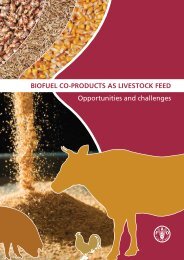Distillers Grains Feeding Recommendations. - Distillers Grains By ...
Distillers Grains Feeding Recommendations. - Distillers Grains By ...
Distillers Grains Feeding Recommendations. - Distillers Grains By ...
You also want an ePaper? Increase the reach of your titles
YUMPU automatically turns print PDFs into web optimized ePapers that Google loves.
USES OF CORN COPRODUCTS IN BEEF AND DAIRY RATIONSTerry Klopfenstein and Rick GrantUniversity of Nebraska, LincolnUSE OF CORN COPRODUCTS FOR BEEF CATTLE<strong>Distillers</strong> grains (DG) are an excellent ruminant feedstuff. They are an excellent source both ofenergy and protein. In the production of alcohol, the starch, which is about two-thirds thecomposition of corn grain, is fermented to alcohol and CO 2 . The remaining nutrients are thenconcentrated by a factor of three. Corn protein of 10% is concentrated to 30% and fat (oil) from4 to 12%. Fiber is concentrated from 14 to 42%. The fiber is highly digestible and the fat hasabout three times the energy of starch. The protein is high in undegraded intake protein (UIP).The DG can be used as both a protein source and an energy source for growing cattle and forfinishing cattle. For growing cattle, the value of the UIP is most important.The DG are normally available for use in feedlot finishing diets in two forms, dried distillers andwet distillers grains. In general, there are two nutritional philosophies regarding their use infeedlot finishing diets. The DG can be fed at 6 to 15% of the diet dry matter (DM), servingprimarily as a source of supplemental protein. When fed at higher levels (greater than 15% ofthe diet DM), the byproduct's primary role is as a source of energy replacing corn grain. Otherthan DM content (wet DG, 35-45%; dried DG, 90-95%), the chemical composition of the twoproducts is similar.Dried DG is routinely fed as a supplemental protein source; however, the drying process appearsto reduce the energy value of the DG. Ham et al. (1994) demonstrated a 9% improvement infeed efficiency when dried DG replaced 40% of the dry-rolled corn in finishing diets (Table 1).However, this improvement was only 50% of that observed when wet DG byproduct replaced asimilar amount of dry-rolled corn. Drying cost significantly increases the commodity price forthe DG. The dried DG is routinely priced relative to other supplemental protein sources likesoybean meal. Therefore, when priced on an energy basis (relative to corn), the expectedimprovement in animal performance is not large enough to offset the increased ration costassociated with higher inclusion levels.Wet DG are commonly fed at higher levels in the diet to supply both protein and energy to theanimal. There are numerous advantages to using wet DG. For the dry-milling plant, the energycost associated with drying the product can be significantly reduced or eliminated. This shouldallow for an overall increased energy yield for each bushel of corn processed. The majordownside of using wet DG is transportation costs associated with the movement of water.Experiments evaluating the use of wet DG in feedlot diets are available (DeHaan et al, 1983;Farlin, 1983; Firkins et al., 1985; Ham et al., 1994; Fanning et al., 1999; Larson et al., 1993;Lodge et al., 1997a; Trenkle, 1997a; Trenkle, 1997b). In the experiments with finishing cattle,the replacement of corn grain with wet DG consistently improved feed efficiency. Larson et al.(1993) replaced dry-rolled corn with 5.2, 12.6, or 40% (DM basis) wet DG (Table 2). With the
















